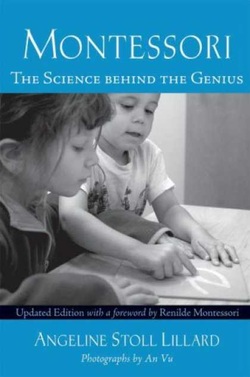
Much of the research that relates the success of a Montessori curriculum is tied to a practitioner of Montessori schooling, leading readers to believe that research is biased. Angeline Lillard’s book, Montessori: The Science Behind the Genius, is an answer to this problem in the field of research related to Montessori curriculum. She has tied recent research in the fields of psychology, neuroscience, child development, and education, to the tenets of the Montessori method in order to build an argument for this form of schooling as a viable alternative to the traditional “factory model” of school. Lillard’s book progresses logically, flows in an interesting and easily navigable manner, and contains the thousands of interesting research tidbits that a psychology major like myself truly enjoys.
Each chapter in this book breaks down a different aspect of child development. Chapter 1 contrasts traditional schooling with the Montessori setting. Chapter 2 explains the role of motor development in learning and draws the connection between physical skill and cognitive skill. Lillard makes an interesting point here—because movement is the expression of interest and reflection of cognitive development (babies take note of objects in their reach; babies develop vision and depth perception as they learn to crawl), the Montessori curriculum uses movement through providing manipulatives. The child learns abstract concepts through concrete actions. For example, a child moves his hands up a number stick, physically able to count the length and order the sticks sequentially. Chapter 3 continues with cognitive development, discussing the importance of child autonomy (choice) and maintaining within the student a high level of perceived control over learning. Chapter 8 continues with this idea of incorporating choice in the classroom by addressing how a teacher’s style of classroom management (a major difference between Montessori schooling and traditional schooling) affects the learning culture.
Chapter 6 explains how Montessori’s mixed-age groupings in classroom produce successful work by highlighting research on peer groups and peer interactions in educational settings. Similar to the social learning theory of Vygotsky, research demonstrates that peer scaffolding seems to be highly effective in improving student performance. Chapter 7 incorporates another practice of Montessori schooling—the situation of new learning in meaningful contexts for the students—by comparing it to research on schema, the importance of prior knowledge in tackling new problems, and the importance of socially meaningful topics of study. Chapter 9 draws a distinction between the classroom environment of a traditional classroom and a Montessori classroom, comparing the level of structure in each setting to that of a successful home routine. Certain home routines have been shown to improve academic outcomes in young children. The nature of those routines align with the classroom environment of a Montessori school rather than that of traditional schooling.
Throughout the whole book, Lillard is definitely advocating for a switch to Montessori schooling; however, the research she uses to support her arguments comes from unbiased, neutral sources. None of the research contained in her book is directly related to a Montessori school—rather, Lillard spends time gently hinting at various possibilities for future research with a specifically Montessori student population. Nevertheless, the research is fascinating, and the implications it holds for education give pause for concern. I look forward to spending more time engaged with this book, taking the ideas within and incorporating them into my own classroom practice.
Each chapter in this book breaks down a different aspect of child development. Chapter 1 contrasts traditional schooling with the Montessori setting. Chapter 2 explains the role of motor development in learning and draws the connection between physical skill and cognitive skill. Lillard makes an interesting point here—because movement is the expression of interest and reflection of cognitive development (babies take note of objects in their reach; babies develop vision and depth perception as they learn to crawl), the Montessori curriculum uses movement through providing manipulatives. The child learns abstract concepts through concrete actions. For example, a child moves his hands up a number stick, physically able to count the length and order the sticks sequentially. Chapter 3 continues with cognitive development, discussing the importance of child autonomy (choice) and maintaining within the student a high level of perceived control over learning. Chapter 8 continues with this idea of incorporating choice in the classroom by addressing how a teacher’s style of classroom management (a major difference between Montessori schooling and traditional schooling) affects the learning culture.
Chapter 6 explains how Montessori’s mixed-age groupings in classroom produce successful work by highlighting research on peer groups and peer interactions in educational settings. Similar to the social learning theory of Vygotsky, research demonstrates that peer scaffolding seems to be highly effective in improving student performance. Chapter 7 incorporates another practice of Montessori schooling—the situation of new learning in meaningful contexts for the students—by comparing it to research on schema, the importance of prior knowledge in tackling new problems, and the importance of socially meaningful topics of study. Chapter 9 draws a distinction between the classroom environment of a traditional classroom and a Montessori classroom, comparing the level of structure in each setting to that of a successful home routine. Certain home routines have been shown to improve academic outcomes in young children. The nature of those routines align with the classroom environment of a Montessori school rather than that of traditional schooling.
Throughout the whole book, Lillard is definitely advocating for a switch to Montessori schooling; however, the research she uses to support her arguments comes from unbiased, neutral sources. None of the research contained in her book is directly related to a Montessori school—rather, Lillard spends time gently hinting at various possibilities for future research with a specifically Montessori student population. Nevertheless, the research is fascinating, and the implications it holds for education give pause for concern. I look forward to spending more time engaged with this book, taking the ideas within and incorporating them into my own classroom practice.
